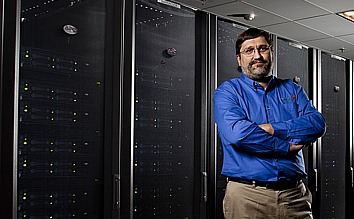ACADEMIA
PNNL expertise highlighted at Supercomputing
From designing supercomputers to solving complex calculations and advancing the smart grid, researchers from the Department of Energy's Pacific Northwest National Laboratory will share their computational expertise at this year's Supercomputing conference.
Also referred to as SC 11, the annual gathering is the international conference for high-performance computing, networking, storage and analysis. It runs Nov. 12-18 at the Washington State Convention Center in Seattle. A few noteworthy PNNL talks are described below.
Computing electrons for synthetic solar power
Media contact: Franny White, (509) 375-6904
To capture solar energy more efficiently than traditional, silicon-based photovoltaics, some scientists are exploring the possibilities of organic light harvesting systems. These synthetic, alternative energy systems could use porphyrin, a type of organic compound that's naturally found in chlorophyll of photosynthesis fame, to capture light and turn it into energy needed to power electronic devices. However, the minute details of how light hitting these hypothetical systems would be transformed into electrons and eventually electrical power aren't well understood. Such information is needed to show whether or not organic light harvesting systems could compete with more conventional solar power devices.
Figuring out how and where electrons would jump into higher-energy, excited states is quite the task. One way is to use a mathematical approach called the equation of motion coupled cluster method, which requires massive amounts of computing resources. PNNL's Karol Kowalski will present a paper that describes how he and his co-authors developed an innovative approach to getting the Cray XT5 Jaguar supercomputer at the Oak Ridge Leadership Computing Facility to perform these calculations. Their strategy included developing new approaches to task scheduling to help Jaguar run the team's complex calculations in the most efficient, speedy manner possible while also adapting to system changes as they occurred. Kowalski wrote the paper with colleagues from PNNL, Oak Ridge National Laboratory and Cray, Inc. The new modeling tool is available as part of NWChem, the open-source computational chemistry software developed and maintained at EMSL and PNNL.
3:30-4 p.m. Thurs., Nov. 17: Scalable Implementations of Accurate Excited-state Coupled Cluster Theories: Application of High-level Methods to Porphyrin-based Systems, Karol Kowalski, Sriram Krishnamoorthy, Ryan Olson, Vinod Tipparaju and Eduardo Apra, The Conference Center, Room 304, Eighth Avenue at Pike Street,
Co-designing the next generation of supercomputers
Media contact: Franny White, (509) 375-6904
Co-design — the practice of developing computer architecture and applications simultaneously instead of one after the other — is often seen as the key to successfully and efficiently developing the next generation of supercomputers. PNNL researchers are actively using the co-design concept in several projects, including collaborating with IBM researchers to jointly develop extreme-scale POWER7-IH HPC-based systems. For this and other projects, PNNL staff have developed performance and power models of applications running on specific IBM system designs. PNNL's models are used to develop optimal systems that balance completing computations quickly and efficiently with using the least amount of power possible.
PNNL's Adolfy Hoisie will describe PNNL's various co-design projects during a panel discussion. PNNL's Darren Kerbyson will also present a paper that analyzes the POWER7-IH's performance. In addition, the November 2011 edition of IEEE Computer will feature an article by Kerbyson and other PNNL researchers titled "Codesign Challenges for Exascale Systems: Peformance, Power and Reliability." The journal will be handed out at the conference.
3:30-5 p.m. Tues., Nov. 15: Holistic Co-Design Approach using Application Performance Modeling and Simulation for System Design, Evaluation, and Optimization, Irene Qualters, William Kramer, Torsten Hoefler, Adolfy Hoisie, Laxmikant Kale, Allan Snavely, Marc Snir, The Conference Center, Room 101, Eighth Avenue at Pike Street,
2-2:30 p.m. Wed., Nov. 16: An Early Performance Analysis of POWER7-IH HPC Systems, Kevin Barker, Adolfy Hoisie, Darren Kerbyson, The Conference Center, Room 303, Eighth Avenue at Pike Street,
Day-long workshop: High performance computing for the future power grid
Media contact: Annie Haas, (509) 375-3736
The use of high performance computing and networking technologies will be critical to the evolution of the future power grid, particularly because of the need for its stable operation in the presence of growing demand for renewable energy such as wind and solar power, the utilization of demand response via the smart grid, and the challenges and opportunities those energy resources place on the electric infrastructure.
A smarter electric power grid, with more sensors and added renewable energy, requires higher fidelity simulation and higher frequency measurement of how the energy is moving through the system. Traditional grid simulation and monitoring tools cannot handle the increased amounts of sensor data, the more distributed and participative control architectures, and/or computation imposed by these trends.
Organized by PNNL's Future Power Grid Initiative, the first annual International Workshop on High Performance Computing, Networking and Analytics for the Power Grid will offer attendees a day-long exploration into various methods and applications for HPC for grid from international experts in this field, from advanced visualization to weather prediction, to stream computing. It is one of the only workshops of its kind, anywhere, dedicated specifically to HPC for the power grid.
8:30 a.m. - 5 p.m., Sunday, Nov. 13: 1st International Workshop on High Performance Computing, Networking and Analytics for the Power Grid, The Conference Center, Discovery Room A, Eighth Avenue at Pike Street,
Energy innovation with computing
PNNL's exhibit booth will also host a talk by Alex Larzelere, director of the Advanced Modeling and Simulation Office within DOE's Office of Nuclear Energy. Larzelere will discuss how DOE's various applied research areas could benefit from high-performance computing and other advanced computing resources. He will explain how using these tools could lead to energy innovation.
1-1:30 p.m., Tuesday, Nov. 15: Unleashing Energy Innovation: Beyond ASC and ASCR - DOE Applied Programs Advanced Modeling and Simulation, Alex Larzelere, Booth # 1103, fourth floor of the Washington State Convention Center, 800 Convention Place, Seattle.

